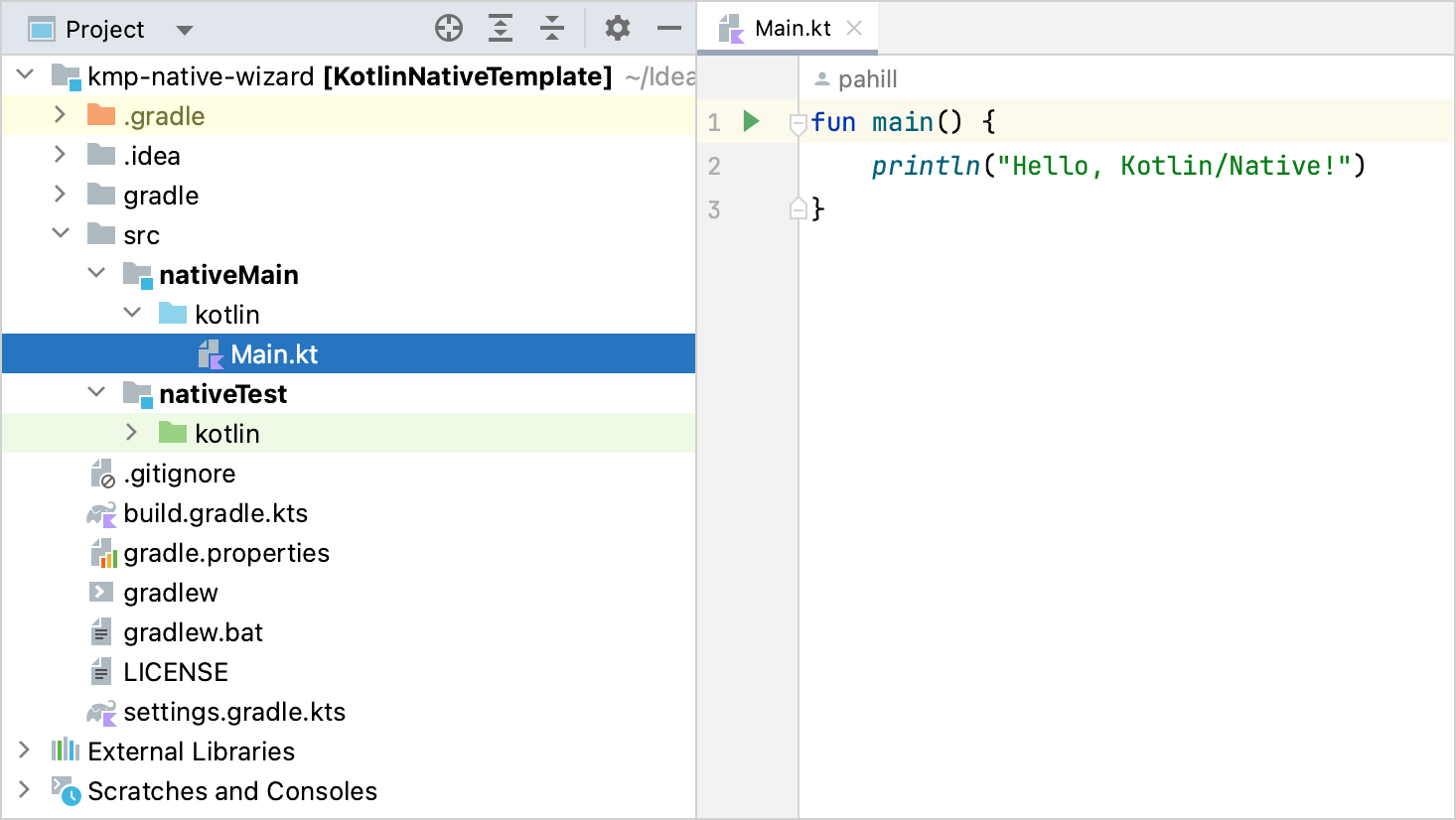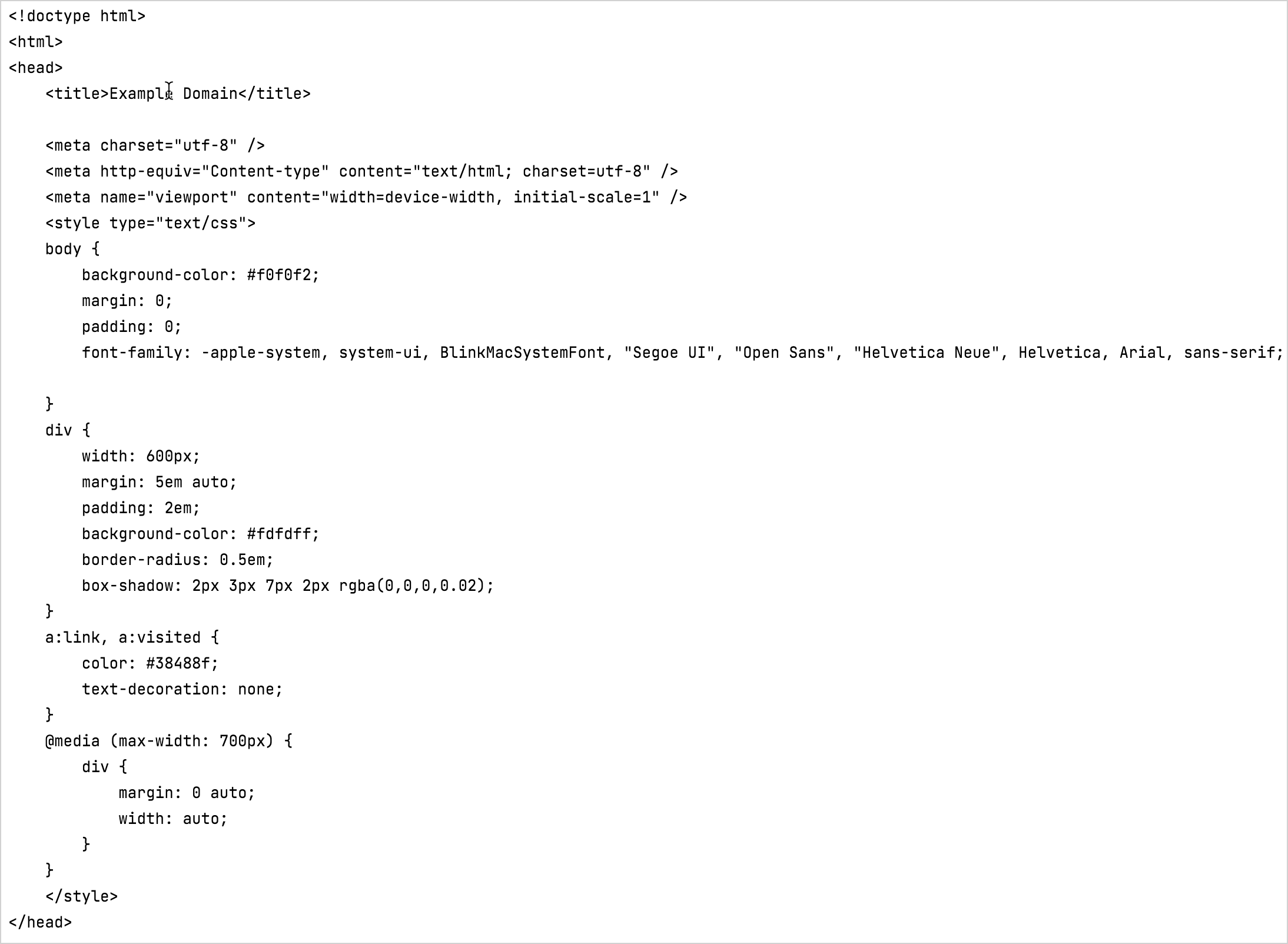Create an app using C Interop and libcurl – tutorial
This tutorial demonstrates how to use IntelliJ IDEA to create a command-line application. You'll learn how to create a simple HTTP client that can run natively on specified platforms using Kotlin/Native and the libcurl library.
The output will be an executable command-line app that you can run on macOS and Linux and make simple HTTP GET requests.
Before you start
Download and install the latest version of IntelliJ IDEA with the latest Kotlin plugin.
Clone the project template by selecting File | New | Project from Version Control in IntelliJ IDEA.
Explore the project structure:

The template includes a project with the files and folders you need to get you started. It's important to understand that an application written in Kotlin/Native can target different platforms if the code does not have platform-specific requirements. Your code is placed in the
nativeMaindirectory with a correspondingnativeTest. For this tutorial, keep the folder structure as is.Open the
build.gradle.ktsfile, the build script that contains the project settings. Pay special attention to the following in the build file:kotlin { val hostOs = System.getProperty("os.name") val isArm64 = System.getProperty("os.arch") == "aarch64" val isMingwX64 = hostOs.startsWith("Windows") val nativeTarget = when { hostOs == "Mac OS X" && isArm64 -> macosArm64("native") hostOs == "Mac OS X" && !isArm64 -> macosX64("native") hostOs == "Linux" && isArm64 -> linuxArm64("native") hostOs == "Linux" && !isArm64 -> linuxX64("native") isMingwX64 -> mingwX64("native") else -> throw GradleException("Host OS is not supported in Kotlin/Native.") } nativeTarget.apply { binaries { executable { entryPoint = "main" } } } }Targets are defined using
macosX64,macosArm64,linuxX64,linuxArm64, andmingwX64for macOS, Linux, and Windows. See the complete list of supported platforms.The entry itself defines a series of properties to indicate how the binary is generated and the entry point of the applications. These can be left as default values.
C interoperability is configured as an additional step in the build. By default, all the symbols from C are imported to the
interoppackage. You may want to import the whole package in.ktfiles. Learn more about how to configure it.
Create a definition file
When writing native applications, you often need access to certain functionalities that are not included in the Kotlin standard library, such as making HTTP requests, reading and writing from disk, and so on.
Kotlin/Native helps consume standard C libraries, opening up an entire ecosystem of functionality that exists for pretty much anything you may need. Kotlin/Native is already shipped with a set of prebuilt platform libraries, which provide some additional common functionality to the standard library.
An ideal scenario for interop is to call C functions as if you are calling Kotlin functions, following the same signature and conventions. This is when the cinterop tool comes in handy. It takes a C library and generates the corresponding Kotlin bindings, so that the library can be used as if it were Kotlin code.
To generate these bindings, create a library definition .def file that contains some information about the necessary headers. In this app, you'll need the libcurl library to make some HTTP calls. To create a definition file:
Select the
srcfolder and create a new directory with File | New | Directory.Name new directory nativeInterop/cinterop. This is the default convention for header file locations, though it can be overridden in the
build.gradle.ktsfile if you use a different location.Select this new subfolder and create a new
libcurl.deffile with File | New | File.Update your file with the following code:
headers = curl/curl.h headerFilter = curl/* compilerOpts.linux = -I/usr/include -I/usr/include/x86_64-linux-gnu linkerOpts.osx = -L/opt/local/lib -L/usr/local/opt/curl/lib -lcurl linkerOpts.linux = -L/usr/lib/x86_64-linux-gnu -lcurlheadersis the list of header files to generate Kotlin stubs. You can add multiple files to this entry, separating each with a\on a new line. In this case, it's onlycurl.h. The referenced files need to be available on the system path (in this case, it's/usr/include/curl).headerFiltershows what exactly is included. In C, all the headers are also included when one file references another one with the#includedirective. Sometimes it's not necessary, and you can add this parameter using glob patterns to fine-tune things.headerFilteris an optional argument and is mostly used when the library is installed as a system library. You don't want to fetch external dependencies (such as systemstdint.hheader) into the interop library. It may be important to optimize the library size and fix potential conflicts between the system and the provided Kotlin/Native compilation environment.The next lines are about providing linker and compiler options, which can vary depending on different target platforms. In this case, they are macOS (the
.osxsuffix) and Linux (the.linuxsuffix). Parameters without a suffix are also possible (for example,linkerOpts=) and applied to all platforms.
The convention is that each library gets its definition file, usually with the same name as the library. For more information on all the options available to cinterop, see the Interop section.
Add interoperability to the build process
To use header files, make sure they are generated as a part of the build process. For this, add the following entry to the build.gradle.kts file:
The new lines are marked with // NL. First, cinterops is added, and then an entry for each def file. By default, the name of the file is used. You can override this with additional parameters:
See the Interoperability with C section for more details on the available options.
Write the application code
Now you have the library and the corresponding Kotlin stubs and can use them from your application. For this tutorial, convert the simple.c example to Kotlin.
In the src/nativeMain/kotlin/ folder, update your Main.kt file with the following code:
As you can see, explicit variable declarations are eliminated in the Kotlin version, but everything else is pretty much the same as the C version. All the calls you'd expect in the libcurl library are available in the Kotlin equivalent.
Compile and run the application
Compile the application. To do that, call
runDebugExecutableNativein the list of run Gradle tasks or use the following command in the terminal:./gradlew runDebugExecutableNativeIn this case, the
cinteropgenerated part is implicitly included in the build.If there are no errors during compilation, click the green Run icon in the gutter beside the
main()method or use the Alt+Enter shortcut to invoke the launch menu in IntelliJ IDEA.IntelliJ IDEA opens the Run tab and shows the output — the contents of
https://example.com:
You can see the actual output because the call curl_easy_perform prints the result to the standard output. You could hide this using curl_easy_setopt.